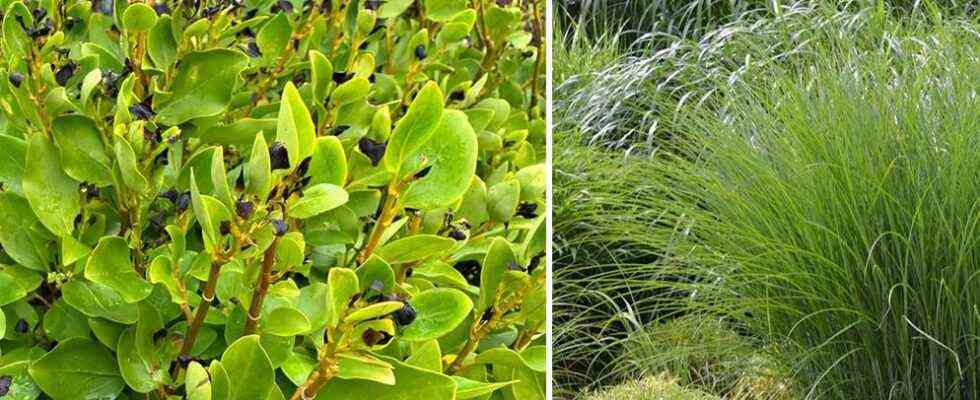Bamboo

Bamboo, due to its rapid growth and evergreen foliage, is a good choice for creating a privacy hedge. On the other hand, be sure to choose a non-tracing variety so as not to be invaded. It is a hardy plant that supports all exposure. You can also grow it in a pot to create a privacy screen on a balcony or terrace.
Griseline

This plant with an upright and rounded port and evergreen foliage will allow you to create a hedge even by the sea. Indeed, it is resistant to wind and spray. Rather rustic, it supports temperatures down to -10 ° C. It can be installed in partial shade or in the sun in rich, cool and slightly acidic soil. Its apple green color will brighten up your garden, but also your balconies if you want to place it in a pot.
Laurier-tin

We appreciate this shrub for its bushy foliage which allows you to isolate yourself from the neighborhood. It is an easy-going shrub that will find its place easily whether in the sun, in the shade or in partial shade. In the ground, it can reach between 2 and 3 m in height. The bay laurel is an interesting shrub even in winter when it is covered with clumps of small white flowers and pink buds.
Cherry Laurel

With its green foliage which is compact and evergreen, it is frequently used to create blackout hedges. When it reaches adulthood, it can measure between 2 and 5 m in height. You can install it in the sun or in partial shade. It is quite rustic and resists temperatures down to -15 ° C. It is attractive throughout the year between its compact foliage, its small white flowers grouped in clusters and its fruits which follow the flowers. Fast growing, easy to maintain and robust, it has many advantages that make it an appreciable choice.
Escallonia

Escallonia seduces with its evergreen foliage and its flowering in the form of red, pink or white panicles throughout the summer. However, it is only suitable for areas where winter is not too harsh. It can tolerate negative temperatures if it is installed in a sheltered location. Opt for a sunny location or in partial shade. It is an easy to grow and vigorous plant in draining, acid to basic soil.
Leyland cypress

This conifer is widely used in the creation of evergreen hedges, whether for use as a screen or windbreak. It is one of the most rustic since it is able to withstand temperatures down to -30 ° C. It can be installed in a sunny or shaded location and prefers regular or well-drained soil. Its rapid growth allows it to benefit quickly. The first year after planting it will need to be watered well. In addition, mulching will protect the plants and prevent the establishment of weeds.
Honeysuckle

To hide an unattractive fence and make it more opaque, it is possible to train climbing plants. You can thus opt for honeysuckle whose lianas will wrap around your fence. Depending on the variety, it can be semi-evergreen or evergreen. For foliage that lasts all year round, you can opt for a Japanese honeysuckle, for example. But whichever variety you choose, from May you will enjoy a beautiful flowering and a delicious fragrance. It can reach between 3 and 5 m high and will find its place in partial shade or in the sun.
Miscanthus

We don’t necessarily think about it, but the grasses form very beautiful graphic hedges, slender and persistent. You can then turn to miscanthus. It comes in different varieties which reach different heights depending on the needs. You can plant them in the sun or possibly in partial shade and enjoy the sound of the wind when it makes them ripple. Miscanthus prefers cool soil and is resistant to temperatures down to about -20 ° C.
Photinia

This fast growing shrub with evergreen foliage that changes from green to red with the seasons is often used for creating hedges. It is also possible to grow it in a container. This shrub is not very demanding in terms of maintenance. To make the most of its white flowering in clusters, a location that is a little sunny or in partial shade is ideal. The more it is in the shade, the less flowers it produces. Photinia is hardy and resistant to temperatures down to -15 ° C, pollution and drought.
Berberis

For a privacy or defensive hedge, you can bet on the evergreen berberis. Indeed, some varieties, like barberry, are armed with thorns, but not all. Depending on its species, the colors of its foliage can vary from green to purple, or from coppery red to carmine red over the seasons. This hardy shrub supports temperatures down to -20 ° C when it is protected from very strong winds. Easy to grow, it adapts to all types of soil, but prefers exposure to the sun or partial shade.
Eleagnus

This botanical genus brings together different species. To create an evergreen hedge, the ideal is to turn to the eleagnus ebbingei, also called “plant of light”. It gets this name from its golden or silver foliage. In summer, it is adorned with pretty little cream or yellow flowers, which give rise to small edible fruits. It is a hardy shrub that adapts to all types of soil and adapts to all situations. It supports drought and spray. Its development is rapid and its culture undemanding.
Mexican orange

To create a privacy hedge, you can stake the Mexican orange tree. It can also be installed in a tank. Not very rustic at first, it finally acclimatized to our regions. Its fragrant greenery which crosses the seasons and, once or twice a year, its bouquets of fragrant white flowers will delight you. It is undemanding and supports all exposures. It prefers a light, drained soil in neutral or slightly calcareous soil.

